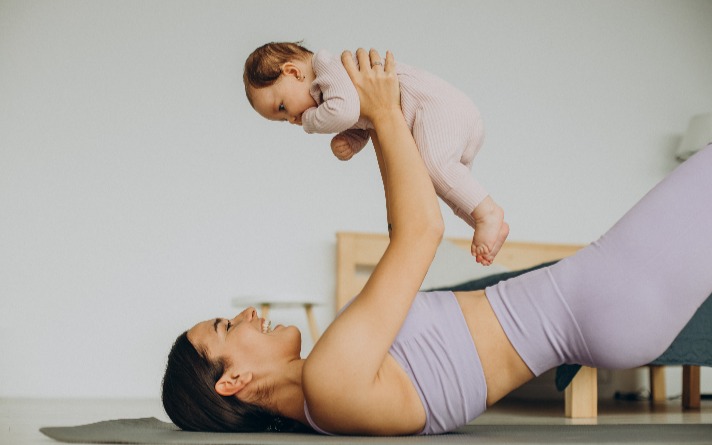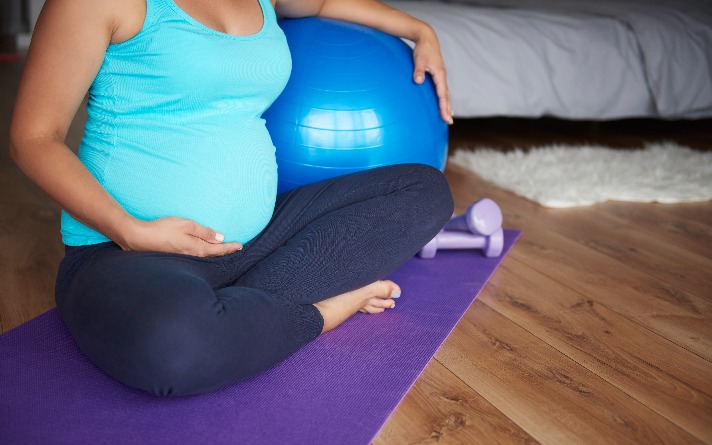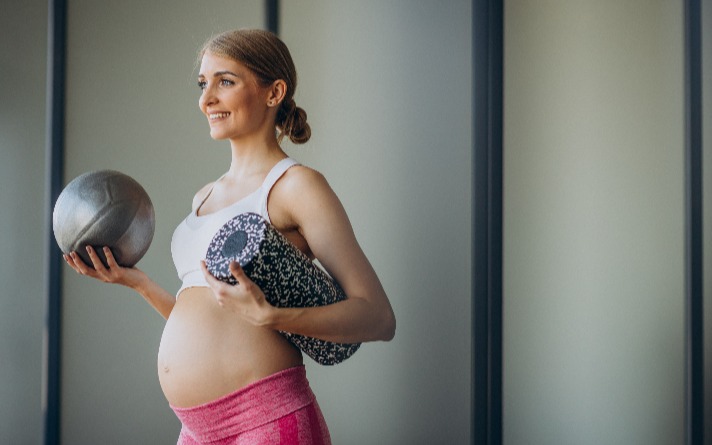At POW8R, we are incredibly passionate about the importance of exercise during pregnancy and postpartum recovery. When your body is experiencing such drastic changes, it can be easy to be reluctant to work out, especially when you’re spending half your day dealing with back pain.
The irony is that exercise can actually help to reduce the feeling of these aches and pains, both before and after labour. There is a distinct difference between how you approach exercise when doing post- and prenatal workouts. In this guide, we will highlight the importance of both workouts and help you understand the key differences between each stage, focusing on maternal fitness throughout the journey.
The Purpose of Prenatal Workouts
Even though exercise is probably the last thing you want to do while pregnant, prenatal workouts can greatly reduce aches and pains and prepare your body for labour.
Exercise during pregnancy can reduce the risk of complications such as gestational diabetes and preeclampsia, while also aiding with problems such as back pain and energy issues, which are commonly experienced during pregnancy.
Completing workouts at all stages of pregnancy can help you maintain strength, mobility, and core stability, which will make you more comfortable during pregnancy and labour.
The Purpose of Postnatal Workouts

We understand that after giving birth, exercise is probably the last thing on your mind. We totally get it, and nobody is suggesting you should leave the labour ward and go straight to the gym, but incorporating some gentle activity into your postpartum recovery can be beneficial.
Though it might be the last thing on your mind, developing a postnatal workout regime and plan can be a great way to encourage healing, regain energy and reduce any back pain that you may be experiencing after pregnancy.
After labour, it is also common for women to experience intense abdominal pain and weakness, and postpartum core exercises can help to rebuild lost strength in that area. Exercise can be fantastic for rehabilitation after pregnancy, helping your core, pelvic floor strength, and overall strength recover.
At POW8R, we are known for having a leading prenatal and postnatal fitness app. Though that is not the prime focus of the app, because we have experience in the importance of exercise after and during pregnancy, our workouts are designed to be accessible and achievable so all mothers can develop their passion for fitness at their own pace.
Key Differences Between Prenatal and Postnatal Workouts
You might wonder what the difference is between prenatal and postnatal workouts and why I can’t just do the same workouts I always did. The truth is that you can continue to do many of the same workouts, but how you approach them changes.
There are key differences between post-pregnancy fitness and prenatal fitness, and here are just some of them.
Timing and Intensity
When you’re pregnant, your workouts are obviously not going to be as intense as your postnatal workouts, especially depending on the stage of your pregnancy.
After 16 weeks, any exercises that require you to lie on your back should be avoided for the safety of the baby, as should high-intensity workouts. A common misconception is that postnatal, you can jump straight back into high-energy, high-intensity workouts, but that’s not the approach you should take.
Postnatal workouts should begin gently, focusing on rebuilding your core and strengthening your pelvic floor muscles. They should gradually increase in intensity as you heal from labour. Many women find postpartum pilates to be an excellent low-impact option for regaining strength and flexibility.
When completing pre- and postnatal exercises, it is recommended that you complete your workouts in short bursts of 15-30 minutes and then gradually increase your time as your strength builds so that your body can make reasonable adjustments.
Body Changes
During the prenatal stage, the body experiences major changes to support the growing baby. These include weight gain, hormonal fluctuations, and shifts in the centre of gravity, which can impact balance, coordination, and stability.

The postnatal period is all about recovery after childbirth. Often, the core and pelvic floor muscles weaken, and conditions such as diastasis recti (abdominal separation) may occur. Your postnatal exercises should always prioritise gentle restoration and the gradual rebuilding of strength. A core recovery program can be particularly beneficial during this time.
A lot of mums focus on regaining a flat tummy after pregnancy, while that isn’t the focus for women who are still prenatal.
Restrictions
Prenatal workouts should be safe and gentle. It’s best to avoid high-impact moves, exercises lying flat on your back after the first trimester, or anything that might cause overheating. Keep movements slow, controlled, and comfortable.
After giving birth, it’s important to be cautious too, steer clear of intense abdominal exercises, heavy lifting, or jumping around until your healthcare provider gives the go-ahead. The main thing is to ease back into exercise gradually and listen to your body’s healing process.
Focus Area
During pregnancy, the main thing is to keep moving, maintain good posture, and get the blood flowing, while also gently working on your core and pelvic floor to support you through each trimester and get ready for labour.
After the baby arrives, the focus shifts to rebuilding and strengthening your core, back, and hips, boosting endurance, and regaining stability. Postnatal workouts are more about restoring function than pushing for performance. This is where a dedicated postpartum fitness routine can make a significant difference.
We understand that it can be challenging to know exactly where to target your pre- and postnatal workouts, but don’t worry, we have you covered. As a leading fitness app for pregnancy (and beyond), we have a whole archive of specifically designed workouts that target a range of areas, from strengthening your core to building overall muscle.
Mental Approach
Prenatal exercise is all about connecting with your body, staying active in a way that feels good, calming your mind, and managing stress. It’s nurturing for both mum and baby.
Postnatal workouts, meanwhile, are about being patient and gentle with yourself. It’s a journey of recovery, getting used to your new body, and finding some balance as you adjust to early motherhood. Postpartum fitness is not just about physical recovery, but also about mental well-being and regaining confidence in your body’s capabilities.
How POW8R Supports Mums at All Stages

We hope this guide has taught you more about how your approach to exercise might change during pregnancy and after birth.
At POW8R, we pride ourselves on being a leading provider of both prenatal and postnatal support for mums, giving them the resources they need to feel better and move more while juggling the stresses of pregnancy and motherhood. Our comprehensive maternal fitness programs cater to women at all stages of their journey.
Whether you’re working out with your infant or taking some much-needed time to complete one of our quick POW8R app workouts, we’re here for you.
With supportive and experienced trainers on your side, it couldn’t be easier to feel more confident while exercising. Download the POW8R app today and join a growing community of mums, dads, and everyone in between who are on a journey to prioritise their health.